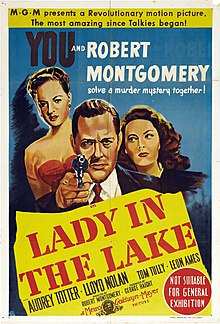| Lady in the Lake | |
|---|---|
 | |
| Directed by | Robert Montgomery |
| Screenplay by | Steve Fisher |
| Based on | The Lady in the Lake 1943 novel by Raymond Chandler |
| Produced by | George Haight |
| Starring | Robert Montgomery |
| Narrated by | Robert Montgomery |
| Cinematography | Paul C. Vogel |
| Edited by | Gene Ruggiero |
| Music by | David Snell |
| Distributed by | Metro-Goldwyn-Mayer |
Release date |
|
Running time | 105 minutes |
| Country | United States |
| Language | English |
| Budget | $1,026,000[1] |
| Box office | $2,657,000[1] |
Lady in the Lake is a 1947 American film noir starring Robert Montgomery, Audrey Totter, Lloyd Nolan, Tom Tully, Leon Ames and Jayne Meadows. An adaptation of the 1943 Raymond Chandler murder mystery The Lady in the Lake, the picture was also Montgomery's directorial debut, and last in either capacity for Metro-Goldwyn-Mayer (MGM) after eighteen years with the studio. Montgomery's use of point-of-view cinematography and its failure was blamed for the end of his career at MGM.
As director, Montgomery's ambition was to create a cinematic version of the first-person narrative style of Chandler's Philip Marlowe novels.[notes 1] With the exception of a pair each of reflections in a mirror and direct addresses to the audience in character Marlowe is never seen: the balance of the film is shot from the point of view of the central character, seeing only what he does. MGM promoted the film with the claim that it was the first of its kind and the most revolutionary style of film since the introduction of the talkies. The movie was also unusual for having virtually no instrumental soundtrack, employing a wordless vocal chorus in lieu.
The film did not use the 195-page screenplay adaptation Chandler penned for MGM in 1945. Instead, a 125-page version written by Steve Fisher was filmed two years later.[2] Seeking to capitalize on an intended Christmas theme, the script changes the novel's midsummer setting to the December, frequently using cheery Christmas themes as an ironic counterpoint to grim aspects of the story. The opening credits appear on a stack of Christmas cards, the last of which reveals a handgun.
- ^ a b The Eddie Mannix Ledger, Los Angeles: Margaret Herrick Library, Center for Motion Picture Study.
- ^ MacShane, Frank (1976). The Life of Raymond Chandler (1st ed.). New York: E.P. Dutton. ISBN 0-525-14552-4.
Cite error: There are <ref group=notes> tags on this page, but the references will not show without a {{reflist|group=notes}} template (see the help page).